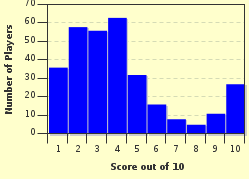Quiz Answer Key and Fun Facts
1. "Language is the blood of the soul" - Oliver Wendell Holmes: Spoken by the Fur (no, I'm not making this up) people of Chad, which language may only have about 12,000 speakers (but they're still speaking it - along, perhaps, with some folks in the Sudan)?
2. Mr Lincoln's War: What was the name of the fourth of the "Seven Days Battles", fought on 29 June, 1862, and cost the life of Brig Gen Richard Griffith?
3. "You make kingdoms and castles on your own" (Stephan Jenkins): Which English castle was the last stronghold of the Royalist forces in the English Civil War?
4. The elements: At Number 62, this bright silvery element ignites in air at 150 degrees F - but you may have some in close proximity to your ears... and it even affects your car! What element is this?
5. Do, re, mi: Which composer, born in 1562, held for 44 years the position previously held by his father, and greatly influenced northern European music?
6. Countries: Named for a relative of a famed explorer, which country is about 21 square km. in size with a population of about 7500, and has few natural resources?
7. Artists: Which artist's brief life was marked with controversy, including a period in gaol for obscenity?
8. Sue Grafton keeps us in suspense: What is the title of the "S" book in the Kinsey Millhone series?
9. Woof, woof: Which large, white dog is a great shepherd and guard dog, not often friendly outside its own family?
10. Authors: Which author started his career with a failed play, a trip on an expedition as a surgeon's mate and an unsuccessful attempt at a medical practice?
Source: Author
CariM0952
This quiz was reviewed by FunTrivia editor
trident before going online.
Any errors found in FunTrivia content are routinely corrected through our feedback system.

